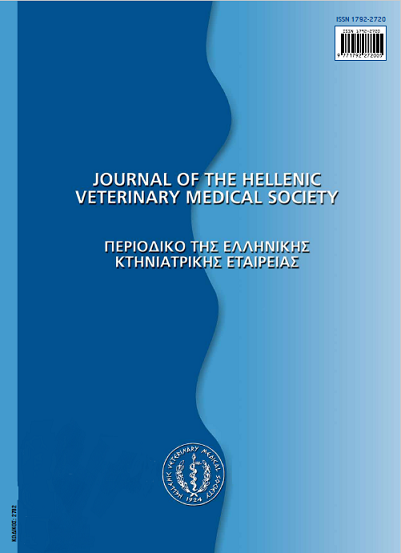Μικροβιολογικοί κίνδυνοι σε διάφορα στάδια της παραγωγής και διάθεσης στην κατανάλωση των Αλλαντικών Θερμικής Επεξεργασίας

Περίληψη
Εξετάσθηκαν 51 δείγματα κρεατοπαστών διαφόρων ειδών αλλαντικών θερμικής επεξεργασίας από δυο αλλαντοβιομηχανίες της Β. Ελλάδας. Η ολική μεσόφιλη χλωρίδα (ΟΜΧ) των κρεατοπαστών αυτών κυμαινόταν 5,3-6,3 Log10CFU/g. Στα ίδια δείγματα παρατηρήθηκε σταθερή η παρουσία σημαντικού αριθμού κολοβακτηριοειδών (93->2.400MPN/g) και οξυγαλακτικών βακτηρίων (5-6,3 Log10CFU/g). Η L. monocytogenes ανιχνεύθηκε σε ποσοστό 56 και 38,4% των δειγμάτων από κάθε αλλαντοβιομηχανία αντιστοίχως. Η E. coli ανιχνεύθηκε σε ποσοστό 20 και 16,6% και η Salmonella spp σε 12 και 16,6% αντιστοίχως. Μετά τη θερμική επεξεργασία των κρεατοπαστών για την παραγωγή των αλλαντικών, σε κανένα δείγμα δεν διαπιστώθηκε η παρουσία των προαναφερθέντων παθογόνων βακτηρίων ούτε και η επιβίωση κολοβακτηριοειδών. Δεν παρατηρήθηκε, επίσης, ανάνηψη τυχόν τραυματισμένων κυττάρων τους μετά τη συντήρηση των ίδιων αλλαντικών σε θερμοκρασία 4°C επί 20 ημέρες. Η ΟΜΧ των αλλαντικών, αμέσως μετά τη θερμική επεξεργασία, κυμάνθηκε 3-4,7Log10CFU/g και αποτελούνταν κυρίως από οξυγαλακτικά (<2-4,5 Log10CFU/g) και σπορογόνα (3-4,5 Log10CFU/g ). Μετά τη συντήρηση των αλλαντικών αυτών στους 4°C επί 20 ημέρες σε κενό, παρατηρήθηκε αύξηση της ΟΜΧ και των οξυγαλακτικών, η οποία σε καμιά περίπτωση δεν ξεπέρασε τον lLog1 0 . Εξετάσθηκαν επίσης από 16 δείγματα από την επιφάνεια και το εσωτερικό μη ενθηκευμένων αλλαντικών θερμικής επεξεργασίας, τα οποία αποτελούνται από μεγάλα ή αυτοτελή τεμάχια κρέατος. Διαπιστώθηκε ότι η ΟΜΧ των δειγμάτων αυτών από τις επιφάνειες κυμαινόταν 5-5,3 Log10CFU/g , ενώ τα δείγματα από το εσωτερικό 2-3,5 Log10CFU/g. Κολοβακτηριοειδή, E. coli, L. monocytogenes, και Salmonella spp δεν ανιχνεύθηκαν. Κυρίαρχη χλωρίδα ήταν τα οξυγαλακτικά βακτήρια. Εξετάσθηκαν επίσης δείγματα από τις επιφάνειες μη ενθηκευμένων αλλαντικών, κατά τις διάφορες φάσεις, από τη θερμική επεξεργασία έως τη συντήρηση τους υπό ψύξη επί 24 ώρες, χωρίς προστατευτική συσκευασία. Η εξέταση έδειξε ότι η ΟΜΧ στην επιφάνεια των αλλαντικών αυτών προέρχεται κυρίως από το περιβάλλον και το νερό των καταιονητήρων ψύξης. Η ΟΜΧ, αμέσως μετά τη θερμική επεξεργασία, ήταν <2 Log10CFU/g, μετά την ψυξη με νερό ήταν 3 Log10CFU/g και μετά 24 ώρες συντήρησης ήταν 3 Log10CFU/g. Στα δείγματα των αλλαντικών μετά τη συντήρηση τους επί 24 ώρες διαπιστώθηκε και η παρουσία κολοβακτηριοειδών. Σε δείγματα μάλιστα αλλαντικών ορισμένων ημερών ο πληθυσμός των κολοβακτηριοειδών ήταν >2.400 MPN/g. Εξετάσθηκαν επίσης 69 δείγματα από τις επιφάνειες του εξοπλισμού τεμαχισμού και συσκευασίας βραστών αλλαντικών τριών αλλαντοβιομηχανιών και 28 δείγματα από τον αντίστοιχο εξοπλισμό 12 καταστημάτων λιανικής πώλησης τροφίμων. L. monocytogenes απομονώθηκε σε ποσοστό 6 και 14,2% των δειγμάτων που προερχόταν από τα μαχαίρια των μηχανών τεμαχισμού των αλλαντοβιομηχανιών και των καταστημάτων λιανικής πώλησης αντιστοίχως. Τα αποτελέσματα αυτά δείχνουν τη σημασία εφαρμογής των κανόνων ορθής υγιεινής πρακτικής, ιδιαίτερα μετά τη θερμική επεξεργασία, στην παραγωγή και διάθεση των αλλαντικών θερμικής επεξεργασίας, για την αποφυγή της μόλυνσης από παθογόνα βακτήρια και την αύξηση των σαπροφυτικών που περιορίζουν το χρόνο ζωής τους.
Λεπτομέρειες άρθρου
- Πώς να δημιουργήσετε Αναφορές
-
SERGELIDIS (Δ. ΣΕΡΓΚΕΛΙΔΗΣ) D., ABRAHIM (Α. AMIN) A., SARIMVEI (Α. ΣΑΡΗΜΒΕΗ) A., & GENIGEORGIS (Κ. ΓΕΝΗΠΩΡΓΗΣ) C. (2018). Μικροβιολογικοί κίνδυνοι σε διάφορα στάδια της παραγωγής και διάθεσης στην κατανάλωση των Αλλαντικών Θερμικής Επεξεργασίας. Περιοδικό της Ελληνικής Κτηνιατρικής Εταιρείας, 53(3), 201–218. https://doi.org/10.12681/jhvms.15375
- Τεύχος
- Τόμ. 53 Αρ. 3 (2002)
- Ενότητα
- Research Articles

Αυτή η εργασία είναι αδειοδοτημένη υπό το CC Αναφορά Δημιουργού – Μη Εμπορική Χρήση 4.0.
Οι συγγραφείς των άρθρων που δημοσιεύονται στο περιοδικό διατηρούν τα δικαιώματα πνευματικής ιδιοκτησίας επί των άρθρων τους, δίνοντας στο περιοδικό το δικαίωμα της πρώτης δημοσίευσης.
Άρθρα που δημοσιεύονται στο περιοδικό διατίθενται με άδεια Creative Commons 4.0 Non Commercial και σύμφωνα με την άδεια μπορούν να χρησιμοποιούνται ελεύθερα, με αναφορά στο/στη συγγραφέα και στην πρώτη δημοσίευση για μη κερδοσκοπικούς σκοπούς.
Οι συγγραφείς μπορούν να καταθέσουν το άρθρο σε ιδρυματικό ή άλλο αποθετήριο ή/και να το δημοσιεύσουν σε άλλη έκδοση, με υποχρεωτική την αναφορά πρώτης δημοσίευσης στο J Hellenic Vet Med Soc
Οι συγγραφείς ενθαρρύνονται να καταθέσουν σε αποθετήριο ή να δημοσιεύσουν την εργασία τους στο διαδίκτυο πριν ή κατά τη διαδικασία υποβολής και αξιολόγησής της.



